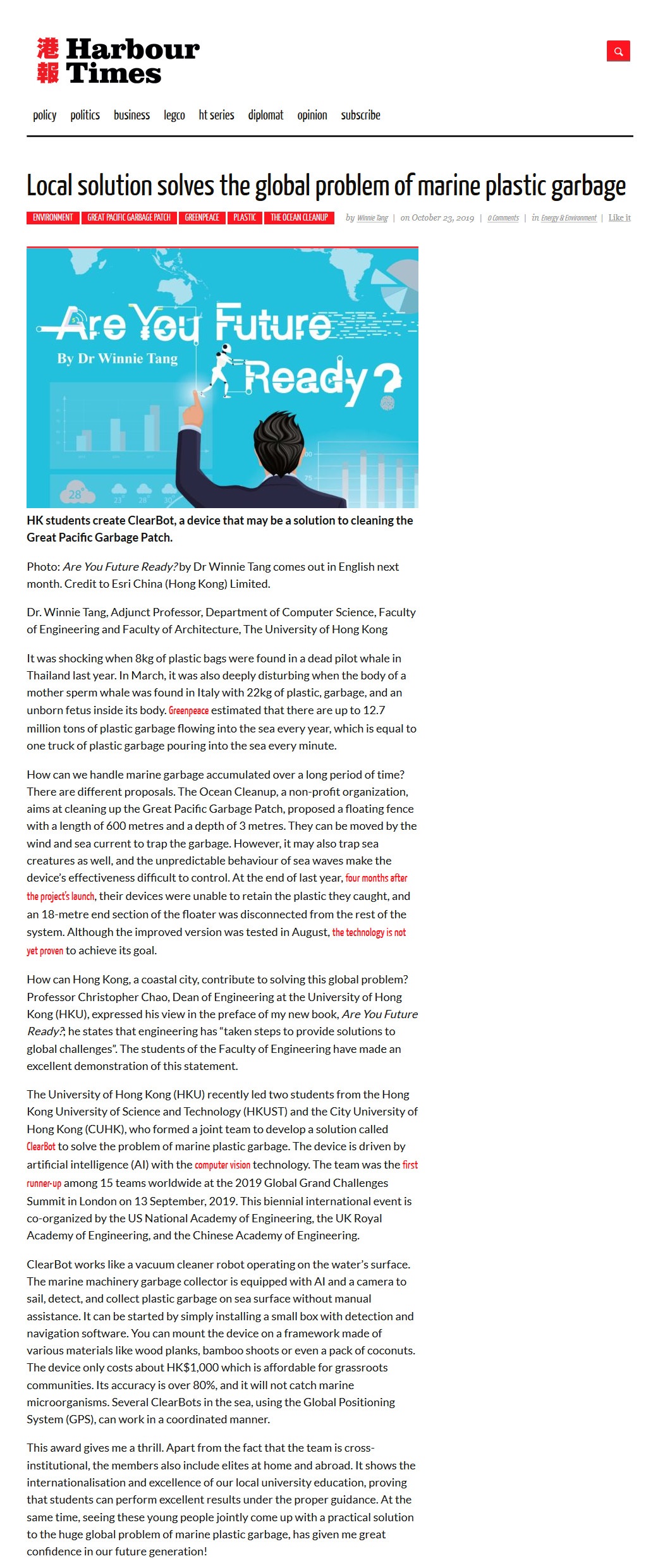網上版請按此

Local solution solves the global problem of marine plastic garbage
It was shocking when 8kg of plastic bags were found in a dead pilot whale in Thailand last year. In March, it was also deeply disturbing when the body of a mother sperm whale was found in Italy with 22kg of plastic, garbage, and an unborn fetus inside its body. Greenpeace estimated that there are up to 12.7 million tons of plastic garbage flowing into the sea every year, which is equal to one truck of plastic garbage pouring into the sea every minute.
How can we handle marine garbage accumulated over a long period of time? There are different proposals. The Ocean Cleanup, a non-profit organization, aims at cleaning up the Great Pacific Garbage Patch, proposed a floating fence with a length of 600 metres and a depth of 3 metres. They can be moved by the wind and sea current to trap the garbage. However, it may also trap sea creatures as well, and the unpredictable behaviour of sea waves make the device's effectiveness difficult to control. At the end of last year, four months after the project's launch, their devices were unable to retain the plastic they caught, and an 18-metre end section of the floater was disconnected from the rest of the system. Although the improved version was tested in August, the technology is not yet proven to achieve its goal.
How can Hong Kong, a coastal city, contribute to solving this global problem? Professor Christopher Chao, Dean of Engineering at the University of Hong Kong (HKU), expressed his view in the preface of my new book, Are You Future Ready?; he states that engineering has "taken steps to provide solutions to global challenges". The students of the Faculty of Engineering have made an excellent demonstration of this statement.
The University of Hong Kong (HKU) recently led two students from the Hong Kong University of Science and Technology (HKUST) and the City University of Hong Kong (CUHK), who formed a joint team to develop a solution called ClearBot to solve the problem of marine plastic garbage. The device is driven by artificial intelligence (AI) with the computer vision technology. The team was the first runner-up among 15 teams worldwide at the 2019 Global Grand Challenges Summit in London on 13 September, 2019. This biennial international event is co-organized by the US National Academy of Engineering, the UK Royal Academy of Engineering, and the Chinese Academy of Engineering.
ClearBot works like a vacuum cleaner robot operating on the water's surface. The marine machinery garbage collector is equipped with AI and a camera to sail, detect, and collect plastic garbage on sea surface without manual assistance. It can be started by simply installing a small box with detection and navigation software. You can mount the device on a framework made of various materials like wood planks, bamboo shoots or even a pack of coconuts. The device only costs about HK$1,000 which is affordable for grassroots communities. Its accuracy is over 80%, and it will not catch marine microorganisms. Several ClearBots in the sea, using the Global Positioning System (GPS), can work in a coordinated manner.
This award gives me a thrill. Apart from the fact that the team is cross-institutional, the members also include elites at home and abroad. It shows the internationalisation and excellence of our local university education, proving that students can perform excellent results under the proper guidance. At the same time, seeing these young people jointly come up with a practical solution to the huge global problem of marine plastic garbage, has given me great confidence in our future generation!
Dr. Winnie Tang
Adjunct Professor, Department of Computer Science, Faculty of Engineering and Faculty of Architecture, The University of Hong Kong